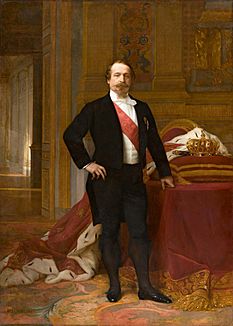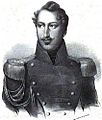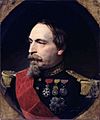Napoléon III facts for kids
Quick facts for kids His ExcellencyNapoleon III The President of France |
|||||
|---|---|---|---|---|---|
 |
|||||
| Emperor of the French | |||||
| Reign | 2 December 1852 – 4 September 1870 |
||||
| Predecessor | Monarchy re-created Louis Philippe I as King of the French |
||||
| Successor | Monarchy abolished Louis Jules Trochu as President of the Government of National Defense |
||||
| Cabinet Chiefs |
See list
|
||||
| President of the French Republic | |||||
| In office | 20 December 1848 – 2 December 1852 |
||||
| Predecessor | Republic re-created Louis-Eugène Cavaignac as Chief of the Executive Power |
||||
| Successor | Republic abolished | ||||
| Prime Ministers |
See list
Odilon Barrot
Alphonse Henri d'Hautpoul Léon Faucher |
||||
| Born | 20 April 1808 Paris, French Empire |
||||
| Died | 9 January 1873 (aged 64) Chislehurst, England |
||||
| Burial | St Michael's Abbey, England | ||||
| Spouse | Eugénie de Montijo | ||||
| Issue | Louis Napoléon, Prince Imperial | ||||
|
|||||
| House | House of Bonaparte | ||||
| Father | Louis I of Holland | ||||
| Mother | Hortense de Beauharnais | ||||
| Religion | Roman Catholicism | ||||
| Signature |  |
||||
Napoléon III, also known as Louis-Napoléon Bonaparte (1808–1873), was a very important leader in French history. He was the first President of the French Republic and later became the last monarch (ruler) of France. He was the nephew of the famous Napoleon I.
Louis-Napoléon was elected president by the people in 1848. Four years later, on December 2, 1852, he made himself Emperor of the French. He ruled until September 1870, when he was captured during the Franco-Prussian War.
Contents
Early Life and Challenges
Before becoming emperor, Napoleon III was known as "Louis Napoléon." He was the son of Louis Bonaparte and Hortense de Beauharnais. His father was made king of Holland, a country controlled by France, during Napoleon I's time.
After Napoleon I was defeated in 1815, his family, the Bonapartes, had to leave France. Louis-Napoléon spent time in exile, including four years in New York, United States. He even sailed to Central America.
He tried to take power in France twice, but both attempts failed. In 1840, he secretly returned to France and tried to start an uprising with some hired soldiers. This attempt failed, and he was sent to prison. While in prison, he spent his time studying and writing.
After his uncle Joseph died in 1844, Louis-Napoléon became the main person who could claim the throne for the Bonaparte family. Two years later, his father Louis died, making his claim even stronger.
In 1848, a revolution in France removed King Louis-Philippe from power and created a new republic. This meant Louis-Napoléon was finally free to return to France.
Becoming the Ruler of France
In 1848, Louis-Napoléon was elected President of France by a huge number of votes. People voted for him because of his famous last name, hoping he would bring back the glory of his uncle, Napoleon I.
He used his position as president to gain more power. In 1852, he crowned himself Emperor Napoleon III, and the Second French Empire began. In 1856, his wife, Eugenie, gave birth to their son and heir, Louis Napoléon, the Prince Impérial.
Napoleon III faced assassination attempts, but he survived them. For the first few years of his rule, his government was very strict. He controlled what newspapers could print and limited the power of the French Parliament.
A big challenge for Napoleon III came from Prussia, a powerful German state. Prussia defeated Austria in a war in 1866, which made France less powerful in Europe. To stop Prussia from becoming even stronger, Napoleon III started the Franco-Prussian War. This war was a disaster for France. In 1870, Prussian forces captured Emperor Napoleon III during the Battle of Sedan. Two days later, his government in Paris was removed from power, and France became a republic again.
Later Life and Death
After being captured, Napoleon III spent his last years living in England with his wife Eugenie and their son. He died on January 9, 1873, in Chislehurst, England. He was very sad about losing his empire and the battle that led to his capture.
He was first buried in a local Catholic church. Later, after his son died fighting in South Africa, his wife Eugenie built a monastery. This monastery became the final resting place for both her husband and her son.
Lasting Impact
One of the most important things Napoleon III did was to completely rebuild Paris. He hired a man named Georges-Eugène Haussmann to oversee this huge project. One reason for the rebuilding was to make it harder for future revolutionaries to block the narrow, old streets with barricades.
However, the main reason was Napoleon III's desire to make Paris a modern city, like London, which he had seen during his time in exile. New wide boulevards, parks, and grand buildings were created, giving Paris the beautiful look it has today.
During his reign, the railway network in France grew a lot, and the first department stores, like Bon Marché, opened. He also supported education, with schools for girls being created and women being allowed into medical school and the famous Sorbonne for the first time.
Images for kids
-
Photographic portrait of Louis Napoleon (1852) by Gustave Le Gray
-
Camille Pissarro, Avenue de l'Opéra, one of the new boulevards created by Napoleon III. The new buildings on the boulevards were required to be all of the same height and same basic facade design, and all faced with cream coloured stone, giving the city center its distinctive harmony.
-
Empress Eugénie in 1853, after her marriage to Napoleon III, by Franz Xaver Winterhalter
-
Napoleon III and Abdelkader El Djezairi, the Algerian military leader who led a struggle against the French invasion of Algeria
-
The French landing near Yevpatoria, Crimea, 1854
-
The French capture of Russian positions around Sevastopol brought the end of the Crimean War.
-
The Battle of Malakoff, 8 September 1855
-
Napoleon III with the French forces at the Battle of Solferino, which secured the Austrian withdrawal from Italy. He was horrified by the casualties, and ended the war soon after the battle.
-
French capture of Gia Dinh (modern Saigon), 17 February 1859
-
Second French intervention in Mexico, 1861–1867
-
Napoleon III commissioned Eugène Viollet-le-Duc to restore the medieval town of Carcassonne in 1853.
-
Victor Duruy, Napoléon III's Minister of Public Education from 1863 to 1869, created schools for girls in every commune of France and women were admitted for the first time to medical school and to the Sorbonne.
-
Louis Bonaparte (1778–1846), the younger brother of Napoleon Bonaparte, the King of Holland, and father of Napoleon III
-
Hortense de Beauharnais (1783–1837), mother to Louis Napoleon in 1808
-
Louis Napoleon's 1840 attempt to lead an uprising against Louis-Philippe ended in fiasco and ridicule. He was sentenced to prison for life in the fortress of Ham in Northern France.
-
After his escape from prison, he had a brief affair with Rachel (1823–1858), the most famous French actress of the time, during her London tours.
-
Georges-Eugène Haussmann and Napoleon III make official the annexation of eleven communes around Paris to the city. The annexation increased the size of the city from twelve to the present twenty arrondissements.
-
The Paris Opera was the centerpiece of Napoleon III's new Paris. The architect, Charles Garnier, described the style simply as "Napoleon the Third".
-
The Bois de Boulogne, transformed by Napoleon III between 1852 and 1858, was designed to give a place for relaxation and recreation to all the classes of Paris.
See also
 In Spanish: Napoleón III Bonaparte para niños
In Spanish: Napoleón III Bonaparte para niños

















































